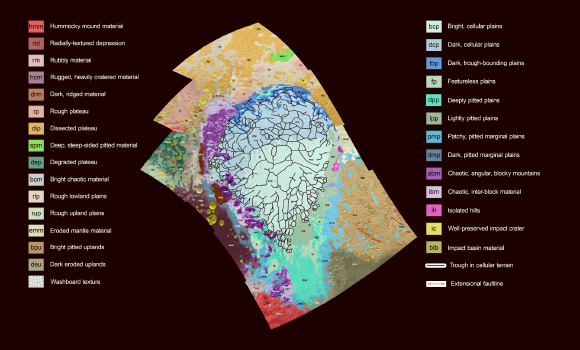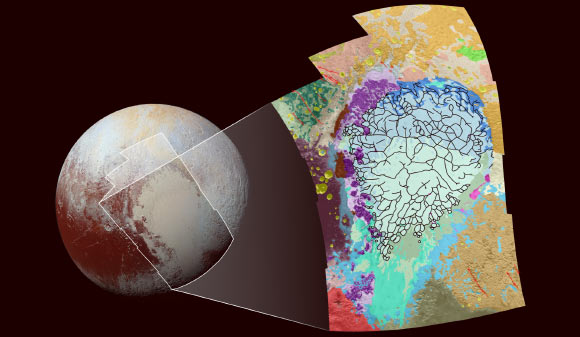NASA scientists have produced this geologic map of one of Pluto’s most dominant features from images taken by New Horizons’ Long Range Reconnaissance Imager (LORRI) instrument.

Geologic map of Pluto’s famous heart-shaped region, Sputnik Planum. Image credit: NASA / Johns Hopkins University Applied Physics Laboratory / Southwest Research Institute.
The new map covers a portion of Pluto’s surface that measures 1,290 miles (2,070 km), and includes the vast nitrogen-ice plain Sputnik Planum and surrounding terrain.
As the key in the figure above indicates, the map is overlaid with colors that represent different geological terrains.
Each terrain, or unit, is defined by its texture and morphology – smooth, pitted, craggy, hummocky or ridged, for example.
The various blue and greenish units that fill the center of the map represent different textures seen across Sputnik Planum, from the cellular terrain in the center and north, to the smooth and pitted plains in the south.
The black lines represent troughs that mark the boundaries of cellular regions in the nitrogen ice.
The purple unit represents the chaotic, blocky mountain ranges that line Sputnik Planum’s western border, and the pink unit represents the scattered, floating hills at its eastern edge.

This map uses colors to represent Pluto’s varied terrains, which helps scientists understand the complex geological processes at work. Image credit: NASA / Johns Hopkins University Applied Physics Laboratory / Southwest Research Institute.
A possible cryovolcanic feature called Wright Mons is mapped in red in the southern corner of the map.
The rugged highlands of Cthulhu Regio are mapped in dark brown along the western edge, pockmarked by many large impact craters, shown in yellow.
By studying how the boundaries between units crosscut one another, New Horizons researchers can determine which units overlie others, and assemble a relative chronology for the different units.
“For example, the yellow craters must have formed after their surrounding terrain,” the scientists said.
“Producing such maps is important for gauging what processes have operated where on Pluto, and when they occurred relative to other processes at work.”







